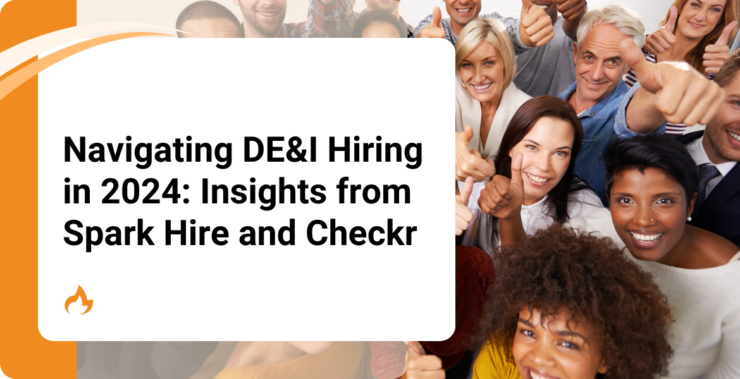This blog post encapsulates the highlights and key takeaways from a webinar hosted by Spark Hire and Checkr on DE&I hiring strategies. Speakers Brenna Walsh (VP, Marketing, Spark Hire) and Arielle Khan (Senior Strategic Partner Manager, Checkr) offered valuable insights for organizations looking to enhance their recruitment processes in alignment with diversity, equity, and inclusion principles.
The Importance of DE&I Hiring
From a business standpoint, studies have proven companies with strong DEI strategies and a more diverse workforce are more successful and bring in higher revenue because they have broader perspectives. Whether we’re talking about race, age, gender, disabilities, or even work experience and geographic location, we need to focus on hiring colleagues with unique perspectives. Having a wealth of different experiences promotes organizational growth and adaptability in an ever-changing world.
To incorporate DE&I strategies into our hiring processes, hiring teams must be aware of potential biases and inequity throughout the entire recruitment process.
Assessing Organizational Readiness
Self-reflection is a great place to kickstart or enhance your DE&I process. Honest assessment may be tough, but it’s important to look critically at your workforce and hiring practices. To better evaluate your current strategy, be sure to include a diverse set of employees in the conversation.
Ask about their experience with the company, what their hiring process felt like, and whether they feel like additional perspectives are needed to achieve greater goals. Look for teams, departments, and roles that may feature less representation and see if there are bottlenecks to hiring more inclusive teams. Only with a diverse group of voices will you be able to shape effective strategies and avoid overly homogenous workforces.
Strategies for Effective DE&I Hiring
One of the best places to start your DE&I hiring journey is by contacting community-based organizations (CBO). These types of organizations can help you connect with candidates directly, and they often host events and diversity-focused job fairs to introduce organizations with underserved candidates. Meeting candidates in person is a great option because oftentimes, candidates will look at a job description and not apply for fear of being underqualified.
When in-person meetings aren’t possible, you can help encourage more candidates to complete applications by partnering with your legal team to craft more detailed and personalized discrimination disclaimers. Calling out your organization’s initiatives and DE&I strategies can help build rapport with candidates before you ever have direct contact.
Be sure to think about how and where you post job openings when considering your candidate sourcing. HR technology can help with candidate attraction, but be sure your tools are user-friendly; they must get candidates into your funnel quickly and be agile enough to adapt to evolving sourcing strategies.
While LinkedIn and Indeed are leaders in the sourcing tech space, you can also consider using DEI job boards or candidate databases. Try engaging with HBCUs or MSIs for early-career candidates, and talk with CBOs about their working communities.
Remember to be flexible in your hiring process to make sure you’re not excluding candidates at the screening and interviewing stages. It’s easy to assume everyone has access to smartphones, high-speed internet, and free time during the 9-to-5 work day, but that may inadvertently rule out otherwise highly qualified candidates.
Gaining Buy-In Internally
If you experience challenges in securing internal buy-in for DE&I hiring initiatives, your organization must begin to foster a culture of inclusivity. From leadership to recruiters to hiring managers, every level of the team must become champions of diversity if you wish to succeed in your efforts. While it will be an investment of time and money, allocating budgets for recruiter anti-bias training, candidate outreach programs, and initiative owners will pay dividends later on.
Initiative owners may be able to engage with employee resource groups (groups that focus on common interests, communities, or goals) to gain perspectives and further conversations. The owners can then become advocates, representing diverse voices and encouraging transparent dialogue with leadership.
Personal testaments can also go a long way in helping team members gain perspective. People who experienced inequity can speak to their challenges, and people who witnessed the benefits of welcoming diversity can speak to the business case for growing inclusivity.
Data Supports Inclusive Business Models
DE&I has been a growing focus in the business world, so it’s important to share the results of inclusivity studies. The Phillips Pathway for Inclusive Leadership was created by Dr. Katherine Phillips from Columbia University, and her work centers around diversity in the workplace.
Dr. Phillips’ studies compared groups’ abilities to effectively solve problems, and she intentionally created homogenous groups and diverse groups to identify differences. Dr. Phillips found that diverse groups outperformed homogenous groups in nearly every round of her study.
Interestingly enough, the diverse groups often assumed they underperformed while the homogenous groups regularly assumed they had succeeded in their tasks. This study highlights people’s perceived qualifications and self-value while also showing that diverse perspectives can lead to higher results.
Additional reporting from McKinsey and Company, SHRM, and Forbes further highlight the correlations between diverse teams and financial outperformance.
Measuring Success and Setting DE&I Goals
You’ll likely want to measure success of DE&I initiatives, so where to begin? Because DE&I encompasses so many candidate attributes and is impacted by every step of employment from application to long-term tenure, there’s no one-size-fits-all approach.
Try starting small. Pick three to five metrics that you can easily measure at particular stages of hiring or employment. Look at your current benchmarks for these metrics, and set yourself a SMART goal (specific, measurable, achievable, relevant, and time-bound).
Maybe you’d like to see how many diverse applicants apply for a job posting, or perhaps you’d like to see which sources drive the most diverse candidates. Consider setting a goal to increase the percentage of diverse applicants, and take note of how many diverse candidates advance to the next interviewing step.
No matter where you choose to start measuring, you’ll be able to recognize successes and opportunities for improvement. Just remember, DE&I initiatives don’t stop once a candidate is hired. Aim for a future workforce that enjoys equitable evaluation, feedback mechanisms, and opportunities for advancement.
Technological Tools for DE&I Hiring
When attracting DE&I candidates to your workforce, it’s essential to meet them where they are in their lives. Underrepresented candidates will greatly appreciate hiring tools that are flexible, easy to use, and help them feel recognized.
Asynchronous interview platforms like Spark Hire provide flexibility with timing and remove the need for commuting or taking time off from a current job. Video interviews allow candidates to present themselves at early interview stages, often conveying far more candidate information than a simple resume or cover letter.
Checkr software helps support fair chance hiring. Background checks can become unnecessary bottlenecks for qualified candidates, so their modernized checks can quickly identify good matches for open roles. Fair chance hiring further widens talent pipelines and helps grow a more diverse workforce.
Equity must continue to be an organizational focus throughout employment, so tools like Trusaic help track pay equity and encourage fair compensation. Pay inequity can easily create unhappy employees and toxic power dynamics, so using HR tech solutions can help retain strong employees and ensure no groups are suffering from discrimination.
Final Thoughts
In a rapidly evolving landscape, DE&I hiring remains a cornerstone of organizational success, necessitating proactive strategies and innovative tools. The insights shared by Spark Hire and Checkr’s HR experts really underscore the importance of collaboration, awareness, and taking actionable steps toward fostering inclusive workplaces.
As we move forward, let’s continue the dialogue, embrace diversity, and strive toward building equitable hiring practices that empower individuals from all walks of life.












